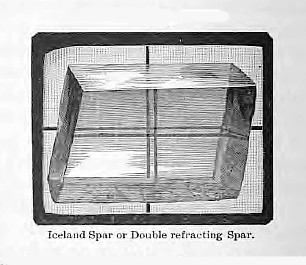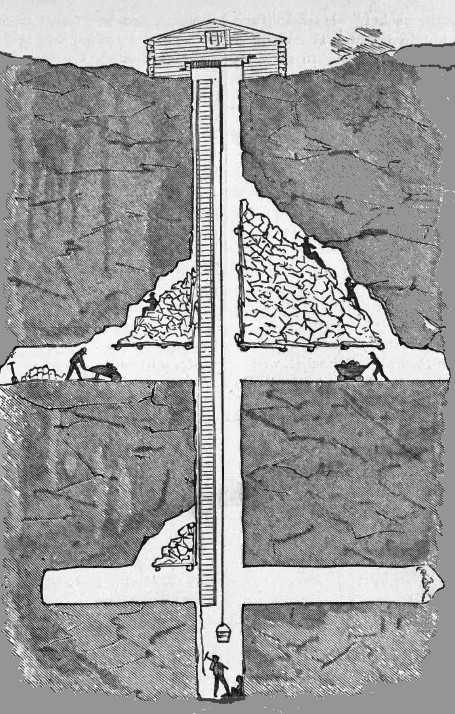When the mineralogist
wishes to know the names of the specimen he holds in his hand, he, in the
case of a mineral difficult to determine, considers all the following
properties:
Crystalline form and structure,
Cleavage,
Fracture,
Tenacity,
Hardness,
Specific Gravity as compared with that of water,
Luster,
Color and Streak,
Transparency or otherwise,
Taste,
Odor,
Chemical Composition tested by analysis,
Pyromorphic characters as determined by the use of the blowpipe,
Mode of occurrence and associated minerals.Crystalline Form and Structure.
Unfortunately the science of crystallography is extremely complicated and
long study is necessary to master it; once acquired, however, it is of
paramount usefulness to the student. According to Dana there are six
systems, to one of which every crystal may be referred. They are: Isometric;
(2) Tetragonal; (3) Hexagonal or Rhombohedral; (4) Orthorhombic ; (5)
Monoclinic; (6) Triclinic.
In the isometric system
there are three equal axes at right angles to each other. In the tetragonal
system there are three axes at right angles to each other. Two of these are
equal, while the third, or vertical angle, is longer or shorter. There are
two divisions of the hexagonal system; the hexagonal system properly
so-called, and its rhombohedral division. All forms are referred to four
axes, three equal axes inclined to each other at angles 60 degrees in a
common horizontal plane, and a fourth vertical axis at right angles, and
longer or shorter. The rhombohedral division comprises crystals having but
three planes of symmetry, intersecting at angles of 120 degrees in the
vertical axis. They are regarded as half forms of the corresponding
hexagonal crystals. In the orthorhombic system there are three unequal axes
at right angles to each other. In the monoclinic system there are three
unequal axes, of which one, the lateral axis, is inclined to the vertical,
while the angles between the others are right angles. In the triclinic
system there are three unequal axes and these intersections are all oblique.
The student who wishes to pursue this subject further should consult Dana's
System of Mineralogy.
Physical Mineralogy. Cleavage is the line of easiest separation in a
mineral. It may be perfect, imperfect, interrupted, etc.
Fracture, referring to any surface except that of a cleavage fall, may be
uneven, conchoidal (shell-like), hackly (rough), etc.
Tenacity refers to such qualities as brittle, sectile, malleable, flexible,
or elastic.
Hardness is represented by the difficulty with which a smooth surface is
scratched. The scale in general ore was devised by Mohs. It is:
1. Talc. Scratched by the ringer nail.
2. Gypsum. Ditto, but with more difficulty. Will not scratch a copper coin.
3. Calcite. Scratched by a copper coin.
4.
Fluorite. Is not scratched by a copper coin and does not
scratch glass.
5. Apatite. Scratches glass, but with difficulty. Is readily scratched by a
knife.
6. Feldspar. Scratches glass with ease. Is difficult to scratch by knife.
7. Quartz. Cannot be scratched by a knife and readily scratches glass.
8. Topaz. Harder.
9. Corundum. Harder.
10. Diamond. Scratches any other substance.
Hardness may be
intermediate. For instance, any mineral that scratched quartz and is soft
enough to be scratched by topaz, in turn would be rated at 7.5. Specific
Gravity. This is the density of mineral and other substances compared with
that of water. It is particularly valuable in determining heavy metals. To
find the specific gravity of any solid body divide its weight in air by the
loss of weight in water, at a temperature as near 60 degrees F. as possible,
and the quotient will equal the specific gravity. In the case of gases, such
as nitrogen, oxygen, etc., hydrogen is taken as the unit.
Luster. There are seven kinds of luster, viz: Metallic, the luster of
metals; adamantine, that of the diamond; vitreous, of broken glass;
resinous, of the yellow resins; greasy; pearly; silky. There are five
degrees of intensity of luster recognized, viz: resplendent, shining;
glistening; glimmering; dull.
Color and Streak. The streak is the color of the powder of the mineral when
rubbed on unglazed porcelain, or scratched with a knife.
Transparency. Minerals may be transparent, subtransparent, translucent,
sub-translucent, opaque.
Taste. Minerals may be salt, bitter, sweet, etc.
Odor. This test is not of much use with most minerals until heat is applied.
All the petroleum oils, however, are often detected by their odor.
Chemical Composition. This may always be determined by suitable tests with
reagents.
Pyromorphic Characters. As a means of readily determining the nature of a
specimen the blowpipe is unrivalled if in the hands of one who understands
it.
Mode of occurrence and associated minerals. A knowledge of these matters
often assists in a determination.
Gold. Practically, the metal most prospectors seek is gold. It is so enormously valuable and constitutes so very small a percentage of any ore, that care must be taken or it may escape detection and be lost. Panning is the miner's method. He crushes his ore thoroughly, and places it in the pan with water; then, with a motion easy to learn but difficult to describe, he swirls the water around, allowing a little of it to escape at each revolution, carrying with it the rubbish, until finally he has a little black sand and perhaps a few grains of yellow substance, which is gold. Mica, or fool's gold, puzzles nobody but the ignoramus. True, it looks like gold in certain positions and lights, but gold will beat out thin under the hammer, just as lead would, while mica will break up into a floury powder. Mica is very light, while gold is very heavy; so there is no excuse for confounding the two. If an ore contains sulfides and gold, the latter may be coated with some sulfur or arsenic, which would prevent the gold from amalgamating. The only remedy for this is roasting. No single acid will dissolve gold, but a solution known as aqua regia, made up of three parts of hydrochloric acid and one part of nitric acid, dissolves it. If to the solution so obtained you add some sulfate of iron, you will get a precipitate which is metallic gold, although it does not look like it, as it is brown in color; but if you place this precipitate in a crucible and heat, you will get a yellow bead of pure gold. Another test for gold is to take the solution as above obtained and add thereto a solution of chloride of tin, when you obtain a purple coloration that has been called the purple of Cassius. Gold may be distinguished from all other metals by the three following tests: It is yellow; it may be flattened by the hammer; it is not acted upon by nitric acid.
Pure gold is soft, and the point of a knife will scratch it deeply. Pounded in a mortar, the pulverized mineral should be passed through a cheese-cloth screen stretched over a loop of wood. If the course contains much pyrite, it must be roasted before washing in the pan and amalgamating. Sample well, weigh out two pounds, put it in a black iron pan, with four ounces of mercury, four ounces of salt, four ounces of soda and a half gallon of boiling water. Stir with a green stick, and agitate until the mercury has been able to reach all the gold. Pan off into another dish so as to lose no mercury, squeeze the amalgam through chamois leather or new calico previously wetted. The pill of hard amalgam may be placed on a shovel over the fire or in a clay tobacco pipe and retorted. Gold is readily acted upon by the mixture of nitric and hydrocloric acids known as aqua regia, or by any solution producing chlorine. Some of the mixtures which attack it are bisulfate of soda, nitrate of soda and common salt, hydrochloric acid and potassium chlorate, and bleaching powder. The action is more rapid in hot than in cold solutions, and impure gold is more easily dissolved than pure.
Mercury dissolves gold rapidly at ordinary temperatures, the amalgam being solid, pasty or liquid. Gold rubbed with mercury is immediately penetrated by it. An amalgam containing 90 per cent of mercury is liquid; 87.5 per cent., pasty; 85 per cent., crystalline. These amalgams heated gradually to a. bright red heat lose all their mercury, and hardly any gold. About one-tenth of 1 per cent, of mercury remains in the gold until it is refined by melting. The veins from which the gold of the world is won do not, on an average, hold the precious metal in greater proportion than one part of gold in 70,000 parts of veinstone. Under favorable conditions a proportion not one-fifth as rich as this, may yield a rich return. In hydraulic mining on a large scale, one part of gold in 15,000,000 parts of gravel has paid a dividend.
Continue on to:
Assaying Placer Gravel Materials:
Return To:
Gold and Silver Prospecting Basics


